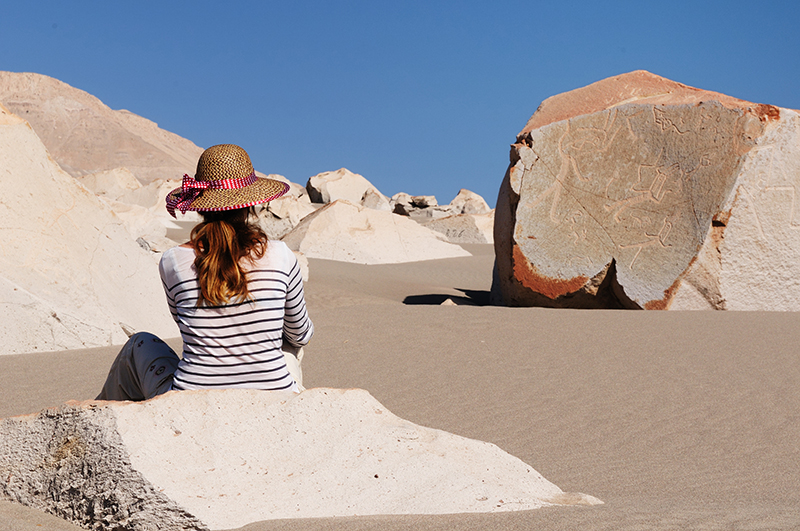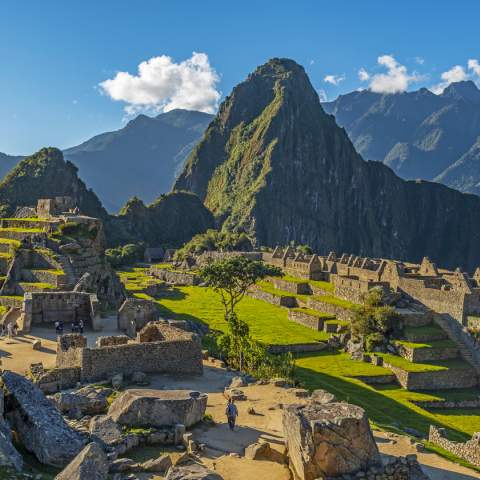06/14/2019

You may have seen an article we shared on Facebook and Twitter recently from Discover Magazine titled “A Brewery in Peru Ran for Centuries, Then Burned After One Epic Ancient Party.” Written by Anna Groves Ph.D, the article digs into the role that chichi, a fermented drink that is an ancient relative of beer, played in the ancient society that brewed it, the blowout party that ended the centuries old establishment and the mission to recreate the drink.
The article also highlights the civilization that brewed the ancient beer: the Wari. As Groves notes in her piece, most people have heard of South America and Central America’s most famous ancient civilizations like the Maya, the Inca and the Aztecs, but the Wari are much more mysterious, largely in part because their reign came to an end hundreds of years before the Spanish arrived in the 1500s. However, their ruined brewery is revealing more about the civilization that reigned in the region for the better part of five centuries (500–1000 CE), than we’ve ever known before, primarily how brewing traditions played a central role in building political relationships in ancient Peru.
Their capital city, Wari (or Huari), was located some 7 miles north-east of the modern city of Ayacucho, the former provisional capital of Peru before Lima took its place. Wari (the city) was inhabited by about 70,000 people at its peak and served as the center of the Wari civilization, which covered much of the highlands and coast of modern day Peru.
Today, the best-preserved remnants of the pre-Columbian civilization are at the capital city, with the archaeological site spanning some 2,000 hectares, and the recently discovered Northern Wari ruins near Chiclayo, and Cerro Baul, the city that once existed at the peak of the imposing rock hill in the middle of the Moquegua Valley.
The Wari successfully exploited the diverse landscape of the region, and were more militaristic than their contemporaries in the great Middle Horizon period like the Tiwanaku and Pukara. Archaeologists believe they were talented agriculturalists, constructing canals to irrigate their fields, which combined with their militaristic strength to create a formidable empire whose methods of maintaining itself, as well as their artistic style, would have a heavy influence on the Inca hundreds of years later.
It is believed that centuries of drought in the region eventually brought the empire down, with the city of Wari depopulating, though archaeologists have found evidence that the Wari people deliberately blocked doorways in buildings with the intention of returning when the rains did. Sadly, for the Wari, when the rains finally did return to the site of their ancient empire, the Wari were gone.
The emerging history of the Wari is just another example of how much South and Central America still has yet to reveal. Evidence of entire empires we know little to nothing about sit just below our feet everywhere we go. Their ancient influence is still reverberating across the continent today and we might not even know it yet. That’s why we never tire of exploring here, no matter how many times we venture out onto some of the same roads first etched into the land thousands of years ago. The next indelible discovery, be it personal or historical, is always waiting for you. Discover fascinating history and culture on your next Peru tour.Submitted by Zach on Fri, 06/14/2019 - 10:14am

You may have seen an article we shared on Facebook and Twitter recently from Discover Magazine titled “A Brewery in Peru Ran for Centuries, Then Burned After One Epic Ancient Party.” Written by Anna Groves Ph.D, the article digs into the role that chichi, a fermented drink that is an ancient relative of beer, played in the ancient society that brewed it, the blowout party that ended the centuries old establishment and the mission to recreate the drink.
The article also highlights the civilization that brewed the ancient beer: the Wari. As Groves notes in her piece, most people have heard of South America and Central America’s most famous ancient civilizations like the Maya, the Inca and the Aztecs, but the Wari are much more mysterious, largely in part because their reign came to an end hundreds of years before the Spanish arrived in the 1500s. However, their ruined brewery is revealing more about the civilization that reigned in the region for the better part of five centuries (500–1000 CE), than we’ve ever known before, primarily how brewing traditions played a central role in building political relationships in ancient Peru.
Their capital city, Wari (or Huari), was located some 7 miles north-east of the modern city of Ayacucho, the former provisional capital of Peru before Lima took its place. Wari (the city) was inhabited by about 70,000 people at its peak and served as the center of the Wari civilization, which covered much of the highlands and coast of modern day Peru.
Today, the best-preserved remnants of the pre-Columbian civilization are at the capital city, with the archaeological site spanning some 2,000 hectares, and the recently discovered Northern Wari ruins near Chiclayo, and Cerro Baul, the city that once existed at the peak of the imposing rock hill in the middle of the Moquegua Valley.
The Wari successfully exploited the diverse landscape of the region, and were more militaristic than their contemporaries in the great Middle Horizon period like the Tiwanaku and Pukara. Archaeologists believe they were talented agriculturalists, constructing canals to irrigate their fields, which combined with their militaristic strength to create a formidable empire whose methods of maintaining itself, as well as their artistic style, would have a heavy influence on the Inca hundreds of years later.
It is believed that centuries of drought in the region eventually brought the empire down, with the city of Wari depopulating, though archaeologists have found evidence that the Wari people deliberately blocked doorways in buildings with the intention of returning when the rains did. Sadly, for the Wari, when the rains finally did return to the site of their ancient empire, the Wari were gone.
The emerging history of the Wari is just another example of how much South and Central America still has yet to reveal. Evidence of entire empires we know little to nothing about sit just below our feet everywhere we go. Their ancient influence is still reverberating across the continent today and we might not even know it yet. That’s why we never tire of exploring here, no matter how many times we venture out onto some of the same roads first etched into the land thousands of years ago. The next indelible discovery, be it personal or historical, is always waiting for you. Discover fascinating history and culture on your next Peru tour.
Most Popular Peru Trips & Tours
| Trip | Price | Days | Highlights |
|---|---|---|---|
| Alternative Inca Trail | $3,995 | 10 Days | Cusco, Ancient Inca Trail , Machu Picchu, Local Perspective , Off the beaten Trek |
| Amazon & Machu Picchu | $3,295 | 9 Days | Amazon Rainforest & Jungle, Amazon Wildlife, Sacred Valley of the Incas, Machu Picchu |
| Classic Inca Trail | $3,995 | 10 Days | Lima, Cusco , Inca Trail Trek, Machu Picchu, Sacred Valley |
| Experience Machu Picchu | $2,995 | 7 days | Lima, Sacred Valley, Cusco, Machu Picchu |















